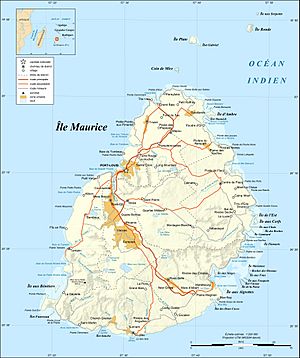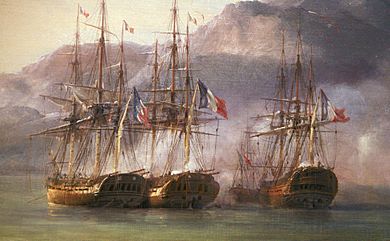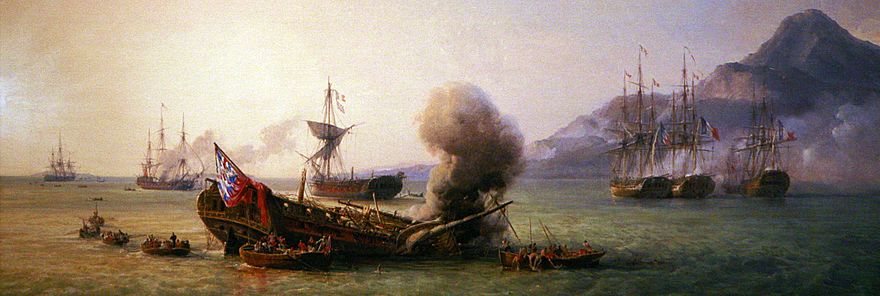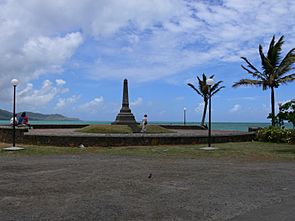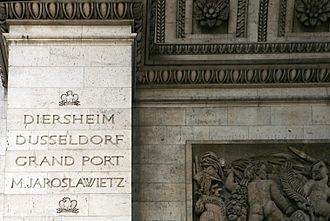Battle of Grand Port facts for kids
Quick facts for kids Battle of Grand Port |
|||||||
|---|---|---|---|---|---|---|---|
| Part of the Napoleonic Wars | |||||||
 Combat de Grand Port, Pierre-Julien Gilbert |
|||||||
|
|||||||
| Belligerents | |||||||
| Commanders and leaders | |||||||
| Strength | |||||||
| 5 frigates 1 corvette 1 brig 2 merchant ships |
4 frigates 1 troopship |
||||||
| Casualties and losses | |||||||
| 37 killed 112 wounded 1 merchant ship captured |
105 killed 163 wounded 2 frigates destroyed 2 frigates captured 1 troopship captured |
||||||
The Battle of Grand Port was a big naval battle. It happened between French and British warships called frigates. The fight took place from August 20 to 27, 1810. It was part of the Napoleonic Wars, a long period of fighting in Europe.
The battle was fought for control of the harbour at Grand Port. This port was on an island called Isle de France, which is now Mauritius. The British wanted to stop the French from using the port. They tried to block it by capturing a fort at the entrance, on a small island called Île de la Passe.
British soldiers took over Île de la Passe on August 13. Nine days later, a French group of ships, led by Captain Guy-Victor Duperré, came near the bay. The British commander, Captain Samuel Pym, decided to trick the French ships. He wanted to lead them into shallow waters for an ambush.
Four of the five French ships managed to get past the British blockade. They found safety in the protected harbour. This area was hard to reach because of many reefs and sandbanks. Only a skilled local harbour pilot could guide ships through.
When Captain Pym ordered his frigates to attack on August 22 and 23, his ships got stuck. Two British ships got stuck on the ground. A third ship was badly outnumbered and defeated. The fourth ship could not get close enough to fire its guns well.
Even though the French ships were also damaged, the battle was a big loss for the British. One ship was captured after being too damaged to fix. The grounded ships were set on fire so the French couldn't capture them. The last British ship was captured as it left the harbour. This happened when the main French fleet, led by Commodore Jacques Hamelin, arrived.
This defeat was the worst the British Navy had during the entire war. It left the Indian Ocean open to attacks from French ships. This ocean was important for trade. The British sent more ships to the area. But these ships arrived one by one and were attacked by the strong French fleet. Finally, in December, a large British fleet arrived. They quickly invaded and captured the Isle de France.
Contents
Why the Battle Happened
During the early 1800s, the Indian Ocean was a key part of trade routes for the British Empire. Large ships called East Indiamen carried valuable goods from British India to the United Kingdom. They also carried soldiers for the British Indian Army.
When the Napoleonic Wars started in 1803, Britain wanted to keep these trade routes safe. By 1807, they had taken over Dutch bases in the area. But the French islands of Île Bonaparte (now Réunion) and Isle de France were harder to capture. They were far away, had strong forts, and many soldiers.
The French knew these islands were good places for their warships to attack British trade. By 1807, France had only a few old warships and many privateers (private ships allowed to attack enemy ships). In 1808, the French Navy decided to send five new, large frigates to Isle de France. Four of these ships got past the British blockade of France. They arrived in the Indian Ocean in 1809.
Commodore Jacques Hamelin led these French ships. He sent them to attack British trade ships. The first success was when the French frigate Caroline captured two valuable merchant ships in May 1809.
British Response and Raids
Commodore Josias Rowley was in charge of the British ships. He had a small fleet, mostly ships from the Cape of Good Hope. He couldn't chase all the French ships. Instead, he decided to blockade the French islands. He also raided them, waiting for Hamelin's ships to return.
In August 1809, Caroline arrived at Saint-Paul on Île Bonaparte. Rowley decided to capture her. He launched a successful attack on the town on September 20. He captured the port's defenses, Caroline, and the merchant ships. Rowley left five days later.
Almost a year later, Rowley returned with a bigger force. He launched another attack on Île Bonaparte's capital, Saint-Denis. His troops quickly took over the island. The French soldiers surrendered, and the island was renamed Île Bourbon.
While the British were busy with Île Bonaparte, Hamelin sent more French frigates to sea. His flagship, Vénus, captured three East Indiamen in November 1809. Another French frigate, Bellone, captured a Portuguese frigate called Minerva. This ship was renamed Minerve by the French.
Minerve later helped capture two more East Indiamen in July 1810. This group of ships was led by Guy-Victor Duperré on Bellone. His ships were so damaged that he had to spend a month repairing them. They fixed their ships in the Comoros Islands before heading back to Isle de France.
Operations Near Grand Port
After Île Bourbon was captured in July 1810, the British had a strong base close to Isle de France. Even before Île Bourbon was fully captured, Rowley sent HMS Sirius to blockade Isle de France again.
Soon after, Captain Samuel Pym of Sirius led a raid on a ship near the island's south side. Two days later, more British ships arrived. These were the frigates HMS Iphigenia, HMS Nereide, and the small brig HMS Staunch.
Nereide carried 100 special soldiers and artillerymen. They were meant to storm and hold offshore islands. Their first target was Île de la Passe, a well-defended island that protected the natural harbour of Grand Port. Capturing these islands would help the British block the ports of Isle de France. This would trap Hamelin's ships.
Grand Port was a good natural harbour because a large coral reef protected it. Only local pilots who knew the way could guide ships through the tricky channel. Île de la Passe was very important because it had a strong battery (a group of cannons) that covered the channel entrance.
The British planned to use the soldiers on Nereide, led by Captain Nesbit Willoughby, to storm Île de la Passe. Then, a local pilot named John Johnson would guide them through the channel. They would land troops near the town and give out leaflets. These leaflets promised freedom under British rule, hoping to lower the French soldiers' spirits.
The first attack on Île de la Passe began on the evening of August 10. Staunch towed boats with over 400 soldiers, Royal Marines, and volunteer sailors. They moved towards the island in the dark. But the pilot got lost, and the boats scattered in strong winds.
To distract the French, Pym ordered Captain Henry Lambert on Iphigenia to sail near Port Napoleon. This was where the main French fleet, led by Hamelin, was based. Pym joined Lambert later, and they sailed back to Grand Port using different routes. This confused the French on shore about British plans.
By August 13, the boats for the attack still hadn't gathered. Pym decided he couldn't wait any longer. He launched his own boats at 8:00 pm. Guided by the pilot, Pym's marines and sailors landed on the island in the dark. They faced heavy fire. Lieutenant Norman, Pym's second-in-command, was killed. But his deputy, Lieutenant Watling, captured the island by storming the fort. Seven British were killed and 18 wounded. They also captured French naval code books and 80 prisoners. Willoughby was angry that Pym had taken over the operation. They exchanged angry letters, showing their distrust.
With Île de la Passe secured, Pym put Willoughby in charge of blocking Grand Port. Pym then returned to Port Napoleon with Iphigenia. Willoughby used his new position to raid the coast. On August 17, he landed at Pointe du Diable with 170 men. He stormed the fort there, destroying ten cannons and capturing another. Willoughby's men fought off French attacks and handed out leaflets. He returned to his ship that evening.
The next day, Willoughby landed again to see the effect of his raids. He burned a signal station and moved inland. But 800 French soldiers arrived from Port Napoleon, forcing him to return to Nereide. This short trip cost the British two wounded and one missing. The French lost at least ten killed or wounded. Willoughby continued with small raids on August 19 and 20.
Duperré's Arrival
Willoughby's raids stopped at 10:00 am on August 20. Five ships were seen quickly approaching from the southeast. These were Guy-Victor Duperré's ships: Bellone, Minerve, the corvette Victor, and two captured merchant ships, Windham and Ceylon. They were returning from the Comoros Islands.
Duperré had repaired his ships and was heading for Isle de France. He planned to enter Grand Port through the channel protected by Île de la Passe. He didn't know the British had captured the island. Willoughby planned to trick the French into the channel by hiding the British presence. He hoped to defeat them or damage them badly. This would trap Duperré's ships away from Hamelin's fleet in Port Napoleon.
Willoughby brought Nereide close to Île de la Passe. This was to combine their fire and protect his boats. These boats were bringing 160 men back to Nereide from a raid that morning.
Willoughby raised a French tricolour flag over Île de la Passe and on Nereide. He sent a French code message they had captured: "The enemy is cruising at Coin de Mire." Duperré replied, confirming he received the message. These signals made Duperré believe Nereide was a French privateer ship, Charles, which they expected. Captain Pierre Bouvet on Minerve disagreed, but Duperré was convinced.
The French ships moved closer to the harbour. Victor entered the channel at 1:40 pm. As Victor passed Nereide and the fort, Willoughby opened fire. Lieutenant Nicolas Morice surrendered the outnumbered corvette after the first shots. Willoughby sent boats to capture Victor, but they couldn't reach it.
Behind Victor, Minerve and Ceylon pushed into the channel. They signaled Morice to follow them, exchanging fire with the fort. As Morice raised his flag again and followed Minerve, a large explosion happened on Île de la Passe. The fake French flag had caught fire on a brazier (a metal container for burning coals). This set off cartridges nearby.
Three men were killed and 12 badly burned. Six cannons were knocked out, and one fired by accident, killing a British sailor. With the fort damaged and many of her crew scattered, Nereide alone couldn't stop the French from entering Grand Port.
Willoughby's ambush plan was ruined. The scattered British boats tried to get back to Nereide. They passed right through the French ships. Even though some boats were almost run over, all eventually returned safely to Nereide. The chance to seriously damage the French in the narrow channel was lost. Bellone joined the French ships, passing through the channel with little trouble.
Besides the explosion, two British men were killed and one wounded on Nereide. French losses were higher: Minerve had 23 casualties, and Ceylon had eight. Both sides knew more fighting was coming. Willoughby sent a boat to Sirius asking for help. Duperré sent a message by land to Hamelin, asking for support. (Lieutenant Morice, who carried the message, fell from his horse and was badly hurt). Command of Victor went to Henri Moisson.
In the afternoon, Willoughby used mortars on Île de la Passe to shell the French ships. This forced Duperré to move into the shallow harbour at Grand Port. On August 21, Willoughby sent officers to Grand Port under a flag of truce. He demanded the release of Victor, saying it had surrendered. Duperré refused.
One French ship, the captured East Indiaman Windham, had not entered the channel. On August 21, its French commander tried to hide it in Rivière Noire. Sirius saw the merchant ship there. Two British boats went into the harbour, stormed the ship, and captured it without any losses. The boarding party had even forgotten their weapons and only used wooden foot-stretchers as clubs!
The Battle Begins
From prisoners captured on Windham, Pym learned about Duperré's ships. He sent orders for Iphigenia and the recently arrived HMS Magicienne to join Sirius and Nereide off Grand Port. Sirius and Nereide met on the morning of August 22. Willoughby signaled Pym, saying the "enemy of inferior force."
But Willoughby's signal was misleading. While Duperré's ships were technically fewer, the French had formed a strong curved line in the bay. They could cover the channel entrance, where British ships could only pass one at a time. Duperré also expected more ships from Port Napoleon. He could also get help from soldiers and cannons on shore. French boats had even moved the buoys (markers) in the channel to confuse the British.
British Ships Get Trapped
On August 22, at 2:40 pm, Pym led an attack on Duperré's ships. He didn't wait for Iphigenia and Magicienne. He entered the channel leading to Grand Port. Nereide followed him. But Willoughby had refused to let Pym take the harbour pilot, who was the only one who knew the way through the reefs.
Without a guide, Sirius ran aground (got stuck) within minutes. It couldn't be moved until 8:30 am the next day. Nereide anchored nearby overnight to protect the flagship. At 10:00 am, Iphigenia and Magicienne arrived. At 2:40 pm, after the captains talked, they tried to go through the channel again.
This time, Nereide's pilot guided them. But Sirius still ran aground again at 3:00 pm. Magicienne got stuck 15 minutes later, trying to avoid the reef Sirius had hit. Nereide and Iphigenia continued the attack. Iphigenia fought Minerve and Ceylon up close. Nereide attacked Bellone. Magicienne also fired at Victor from a distance.
Within minutes, Ceylon surrendered. Boats from Magicienne tried to capture her but failed. The French crew drove Ceylon onto the shore. Soon after, Minerve, Bellone, and later Victor also ran aground. By 6:30 pm, all the French ships were stuck. All but Bellone couldn't fire their main cannons because other ships blocked their view.
Bellone was perfectly placed to keep firing at Nereide. At 7:00 pm, a cannon shot cut Nereides back anchor cable. The British frigate spun around, showing its back to Bellone. This also moved its cannons away from the French ships. Bellone fired directly into Nereides back. Desperate to fire back, Willoughby cut the front anchor cable. This allowed some of his ship's cannons to aim at Bellone.
At 8:00 pm, Duperré was badly wounded in the cheek by shrapnel. An officer hid him and took him below deck. Bouvet took command of the French ships on Bellone. He put Lieutenant Albin Roussin in charge of Minerve. Bouvet built a makeshift bridge between the French ships and the shore. This allowed more men and ammunition to reach Bellone, making it fire faster. He also added more guns to Minerve.
By 10:00 pm, Nereide was a wreck. It was being hit from many sides. Most of its cannons were broken, and over 200 men were hurt. The first officer was dying, the second was badly wounded, and Willoughby's left eye was knocked out by a wooden splinter. Seeing how damaged Nereide was, Bouvet then focused fire on Magicienne.
Willoughby refused to surrender until he had no other choice. He sent boats to Sirius, asking Pym if they could tow Nereide away. Pym replied that his boats were busy trying to free Sirius and Magicienne. He couldn't send them to tow Nereide under fire. Pym also suggested Willoughby take his men off and set his ship on fire. This was hoped to spread flames to the French ships. Willoughby refused. It was too hard to get the many wounded men off Nereide in the dark. He also refused to leave his men when Pym ordered him to move to Sirius.
At 11:00 pm, Willoughby ordered a boat to row to Bellone and tell the French commander he surrendered. But Willoughby's boat had a hole from a cannon shot and couldn't make the short trip. The message was instead carried by French prisoners from Nereide. They had jumped overboard and reached the shore. Remembering the fake flags used on August 20, Bouvet decided to wait until morning to accept the surrender.
British Try to Escape
At 1:50 am on August 24, Bellone stopped firing at the broken Nereide. During the rest of the night, Pym kept trying to free Sirius from the reef. He sent orders to Lambert, whose Iphigenia had been blocked from firing by Nereide. It was also blocked from chasing Minerve by a large reef.
With Iphigenia now stuck in the calm coastal waters, Pym told Lambert to start warping his ship out of the harbour. This meant using anchors and a capstan to slowly drag the ship through the shallow water. Magicienne, like Iphigenia, had been stuck out of range of the French ships. So, she had fired at a shore battery, destroying it by 2:00 am.
When daylight came, it was a confusing sight. Sirius and Magicienne were stuck near the harbour entrance. The French ships were "on shore in a heap," as Pym described. Iphigenia was slowly pulling herself away. Nereide lay broken under Bellone's guns, with a Union Flag nailed to its mast. This flag caused Bouvet to fire again. It wasn't until Willoughby ordered the mizenmast (a mast on a ship) to be chopped down that the French accepted the surrender and stopped firing.
At 7:00 am, Lambert told Pym that he had cleared the reef. He suggested that if Pym sent more men from Sirius, they might be able to board and capture all the French ships. Pym refused. He insisted Lambert help him pull Sirius off the reef instead. Although Lambert wanted to attack the French alone later, Pym forbade him. He sent a direct order for Lambert to move out of enemy range.
At 10:00 am, Iphigenia reached Sirius. Together, the ships started firing at French troops on shore. These troops were trying to set up a gun battery within range of the frigates. Magicienne was hopelessly stuck on the reef, filling with water, and her capstan was smashed. She took the brunt of long-range French fire. Pym ordered Captain Curtis to abandon his ship and transfer his men to Iphigenia. At 7:30 pm, Magicienne was set on fire. Her magazines (where ammunition is stored) exploded at 11:00 pm.
On the shoreline, Duperré couldn't spare any men to take over Nereide until 3:00 pm. A group led by Lieutenant Roussin was sent. They were ordered to return after disarming the ship. Roussin freed the remaining French prisoners. He spiked the guns (made them unusable), gave basic medical care, and returned to shore. He reported that over 100 men were dead or dying on the British frigate.
At 4:00 am on August 25, the new French gun battery opened fire on Sirius and Iphigenia. They fired back as best they could. Pym accepted that Sirius couldn't be fixed. He removed all her crew and military supplies. He set fire to the frigate at 9:00 am. This was shortly after Iphigenia had moved out of range of the battery. French boats tried to reach Sirius to capture her before she exploded. But they turned back when Pym sent his own boats to stop them. The frigate's remaining ammunition exploded at 11:00 am.
During the morning, Duperré sent an official boarding party to Nereide. They wet the decks to prevent fire from the burning ships. They also removed 75 bodies from the frigate.
British Surrender
On the morning of August 28, Lambert received a message from Hamelin. Hamelin promised to release all prisoners within one month if Île de la Passe and Iphigenia were surrendered without a fight. The message also threatened that if Lambert refused, the French would attack and defeat the outnumbered British.
Lambert knew food supplies were low, no help had arrived, and his ammunition was almost gone. He agreed to the terms. Lambert later received a similar offer from Governor Charles Decaen. He told Decaen he had already surrendered to Hamelin. Decaen was angry that Hamelin had made terms without him. But he eventually agreed to accept the surrender terms.
The wounded British soldiers were treated by French doctors at Grand Port. They were later sent home. However, the other prisoners were put in a crowded prison at Port Napoleon. Despite the surrender terms, they were not released until British forces captured the island in December.
Rowley first learned about the Grand Port events on August 22. Windham arrived off Saint Paul. Eager to help Pym, Rowley immediately sailed in his frigate HMS Boadicea. The transport ship Bombay followed with soldiers to guard any captured land. Strong headwinds meant Rowley didn't arrive off Grand Port until August 29. He had been told about the situation by Magicienne's boat the day before.
Rowley saw a group of frigates near Île de la Passe. He moved closer, then quickly turned away when Vénus and Manche raised their flags and chased him. Rowley kept pretending to attack the French ships, then pulling away. He hoped to draw them away from Grand Port. This would allow Bombay to capture the unprotected Iphigenia. But Bombay was stopped by the arrival of Astrée and Entreprenant. Rowley was chased by Vénus and Manche back to Saint Denis, where he anchored on August 30. Rowley tried again to rescue Iphigenia the next week. But by then, Bellone and Minerve had been refloated. The French force was too strong for Rowley's ship to attack alone.
What Happened After the Battle
The Battle of Grand Port was the biggest defeat for the British Royal Navy during the Napoleonic Wars. Four frigates were lost, along with their entire crews. 105 experienced sailors were killed, and 168 were wounded. It was one of the bloodiest frigate battles of the war.
French losses were also heavy. Duperré reported 36 killed and 112 wounded among his sailors and the soldiers on shore.
The loss of so many ships put Rowley at a big disadvantage in September. Hamelin's fleet, now stronger with the newly captured Iphigénie, greatly outnumbered Rowley's ships. (The ruined Néréide was also part of the French fleet, but it was too damaged to ever sail again).
Rowley went back to Isle de France. He asked for more ships to replace his lost ones. He also wanted to break the French blockade of Île Bourbon. These new British frigates, sailing alone, became targets for Hamelin. He twice forced single British frigates to surrender. But each time, Rowley managed to chase Hamelin's ships away from their prizes.
The second time, Rowley was able to chase and capture Hamelin and his flagship Vénus. This ended Hamelin's raiding career. His ships stayed on Isle de France until they were all captured when the island fell in December. This happened during an invasion led by Vice-Admiral Albemarle Bertie.
In France, the battle was celebrated. It became the only naval battle remembered on the Arc de Triomphe in Paris. The British were sad about the loss. However, all four British captains were later cleared of blame and praised. The only criticism was of Willoughby, for giving a misleading signal about the French being weaker.
Historian William James wrote that the brave actions of the British officers and crew made the defeat at Grand Port seem less bad. He said that "in public opinion at least, the loss of four frigates was scarcely considered a misfortune." He also noted that "No case of which we are aware more deeply affects the character of the Royal Navy than the defeat it sustained at Grand Port." On December 30, 1899, a monument was built at Grand Port harbour. It remembers the British and French sailors who died in the battle.
The Battle in Books
The Battle of Grand Port has appeared in several books:
- The 1843 novel Georges by Alexandre Dumas.
- "Dead Reckoning" by C. Northcote Parkinson.
- The 1977 novel The Mauritius Command by Patrick O'Brian.
Monuments and Memorials
On December 30, 1899, a monument was put up at the Grand Port harbour. It honors the British and French sailors who died in the battle.
Ships Involved
Here are the ships that took part in the battle:
| Captain Pym's squadron (British) | ||||||||||
|---|---|---|---|---|---|---|---|---|---|---|
| Ship | Type | Guns | Navy | Commander | Casualties | Notes | ||||
| Killed | Wounded | Total | ||||||||
| HMS Sirius | Fifth-rate | 36 | Captain Samuel Pym | 0 | 0 | 0 | Sunk by its crew to avoid capture. | |||
| HMS Iphigenia | Fifth-rate | 36 | Captain Henry Lambert | 5 | 13 | 18 | Surrendered on August 27. | |||
| HMS Nereide | Fifth-rate | 32 | Captain Nesbit Willoughby | 92 | 130 | 222 | Surrendered on August 24. | |||
| HMS Magicienne | Fifth-rate | 32 | Captain Lucius Curtis | 8 | 20 | 28 | Sunk by its crew to avoid capture. | |||
| Total British Casualties: 105 killed, 163 wounded, 268 total. All survivors were captured. | ||||||||||
| Captain Duperré's squadron (French) | ||||||||||
|---|---|---|---|---|---|---|---|---|---|---|
| Ship | Type | Guns | Navy | Commander | Casualties | Notes | ||||
| Killed | Wounded | Total | ||||||||
| Bellone | Fifth-rate | 40 | Captain Guy-Victor Duperré | 13 | 35 | 48 | ||||
| Minerve | Fifth-rate | 48 | Captain Pierre Bouvet | 15 | 42 | 57 | ||||
| Victor | Corvette | 18 | Lieutenant Nicolas Morice (Later Henri Moisson) |
4 | 1 | 5 | ||||
| Ceylan | Captured East Indiaman | 26 | Lieutenant Vincent Moulac | 4 | 19 | 23 | ||||
| Windham | Captured East Indiaman | 26 | Ensign d'Arod | 0 | 0 | 0 | Captured by HMS Sirius on August 21. | |||
| Total French Casualties: 36 killed, 112 wounded. | ||||||||||
| Commodore Hamelin's reinforcements (French) | ||||||||||
| Vénus | Fifth-rate | 40 | Commodore Jacques Hamelin | — | — | — | ||||
| Manche | Fifth-rate | 40 | Captain Jean Dornal de Guy | — | — | — | ||||
| Astrée | Fifth-rate | 40 | Captain René Le Marant | — | — | — | ||||
| Entreprenant | Brig | 16 | Captain Pierre Bouvet | — | — | — | ||||
| Sources: Macmillan pp. 29–37, James pp. 273–289 | ||||||||||


